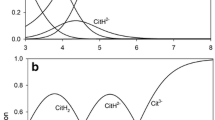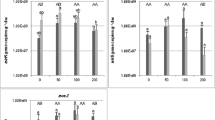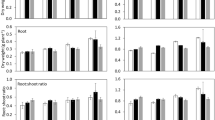Abstract
The exudation of soluble carbon compounds from Zea mays roots was investigated over a 10 day growth period under sterile and non-sterile solution culture conditions. The results showed that plants grown in sterile static solution culture, where C was allowed to accumulate, released 8 times less C than plants grown under culture conditions in which the solutions were replaced daily.
The increased C loss from plant cultures in which exudates were removed daily was attributable to, (a) the reduced potential for root re-sorption of previously lost C, and (b), increasing diffusion gradients between the root and the surrounding bathing solution increasing passive leakage of exudates from the roots. In treatments where C was removed daily from the root-bathing solution, 86% of the total C lost was of a soluble low molecular weight nature, whereas, in sterile and non-sterile static cultures, allowing the accumulation of C over 10 days, this was reduced to 67.5 and 48% respectively.
The main C fluxes operating in a solution culture system (efflux and influx of C by both roots and microorganisms) were examined using a computer simulation model to describe movement of soluble sugar-C in both sterile and non-sterile conditions. In sterile static cultures where C was allowed to accumulate in solution over a 10 day growth period, 98% of the C exuded was re-absorbed by the plant. Where C was removed daily from the root-bathing solution this was reduced to 86%. The predicted patterns of C accumulation were similar to those found in the experiments. Simulations showed that the pattern of accumulation and final equilibrium concentrations were dependent on the rate of exudation, the spatial characteristics of exudation, solution volume, root growth rate and the presence of a microbial population. Simulations under non-sterile conditions showed that roots can compete with microorganisms for exudates in solution indicating the possible importance of re-sorption in a soil environment.
The results clearly indicate that roots are capable of regulating the net amount of C released into a solution culture with the amount of C collected being highly dependent on the experimental conditions employed. The possible implications of soluble C influx on processes operating within the rhizosphere and in experimental systems is discussed.
Similar content being viewed by others
References
Barber D A and Gunn K B 1974 The effect of mechanical forces on the exudation of organic substances by the roots of cereal plants grown under sterile conditions. New Phytol. 73, 39–45.
Biondini M, Klein D A and Redente E F 1988 Carbon and nitrogen losses through root exudation by Agropyron cristatum, A. smithii and Bouteloua gracilis. Soil Biol. Biochem. 20, 477–482.
Bowen G D and Rovira A D 1973 Are models useful in rhizosphere biology? Bull. Ecol. Res. Comm. 17 443–450.
Bradford M M 1976 A rapid and sensitive method of μg quantification of protein using the principle of protein-dye binding. Anal. Biochem. 72, 248–254.
Briskin D P and Hanson J B 1992 How does the plant plasma membrane H+-ATPase pump protons? J. Exp. Bot. 43, 269–289.
Cakmak I and Marschner H 1988 Increase in membrane permeability and exudation in roots of zinc deficient plants. J. Plant Physiol. 132, 356–361.
Chaboud A 1983 Isolation, purification and chemical composition of maize root cap slime. Plant and Soil 73, 395–402.
Chaboud A and Rougier M 1984 Identification and localization of sugar components of rice (Oryza sativa L.) root cap mucilage. J. Plant Physiol. 116, 323–330.
Chen T H, Chen T L, Hung L M and Huang T C 1991 Circadian rhythm in amino acid uptake by Synechococcus RF-1. Plant Physiol. 97, 55–59.
Coody P N, Sommers L E and Nelson D W 1986 Kinetics of glucose uptake by soil microorganisms. Soil Biol. Biochem. 18, 283–289.
Curl E A and Truelove B 1986 The Rhizosphere. Springer-Verlag, Berlin.
Darrah P R 1991a Models of the rhizosphere. I. Microbial population dynamics around a root releasing soluble and insoluble carbon. Plant and Soil 133, 187–199.
Easton G D and Nagle M E 1985 Timing and root absorption affecting efficiency of metalaxyl in controlling Phytophthora infestans on potato in northest Washington state. Plant Disease 69, 499–500.
Ebell L F 1969 Variation in total soluble sugars of conifer tissues with method of analysis. Phytochemistry 8, 277–233.
Griffin G J, Hale M G and Shay F J 1976 Nature and quantity of sloughed organic matter produced by roots of axenic plants. Soil Biol. Biochem. 8, 29–32.
Haller T and Stolp H 1985 Quantitative estimation of root exudation in maize plants. Plant and Soil 86, 207–216.
Hoffland E 1992 Quantitative evaluation of the role of organic acid exudation in the mobilization of rock phosphate by rape. Plant and Soil 140, 279–289.
Holden J 1975 Use of nuclear staining to assess the rates of cortical cell death in cortices of cereal roots, Soil Biol. Biochem. 7, 333–334.
Horst W J, Wagner A Marschner H 1982 Mucilage protects roots meristems from aluminium injury. Z. Pflanzenphysiol. 105, 435–444.
Jones D L and Darrah P R 1992a Re-sorption of organic compounds by roots of Zea mays L. and its consequences in the rhizosphere I. Re-sorption of glucose, mannose and citric acid. Plant and Soil 143, 259–266.
Jones D L and Darrah P R 1993 Re-sorption of organic compounds by roots of Zea mays L. and its consequences in the rhizosphere. III. Spatial and selectivity characteristics of influx and the factors controlling efflux. Plant Physiol. submitted.
Kraffczyk I, Trolldeiner G and Beringer H 1984 Soluble root exudates of maize: Influence of potassium supply and rhizosphere microorganisms. Soil Biol. Biochem. 16, 315–322.
Liljeroth E, Baath E, Mathiasson I and Lundborg T 1990 Root exudation and rhizoplane bacterial abundance of barley (Hordeum vulgare L.) in relation to nitrogen fertilization and root growth. Plant and Soil 127, 81–89.
Matsumoto H, Okada K and Takahashi E 1979. Excreting products of maize roots from seedling to seed development stage. Plant and Soil 53, 17–26.
Meiners S, Gharyal P K and Schindler M 1991 Permeabilization of the plasmalemma and wall of soyabean root cells to macromolecules. Planta 184, 443–447.
Mench M, Morel J L, Guckert A and Guillert B 1988 Metal binding with root exudates of low molecular weight. J. Soil Sci. 39, 521–527.
Mench M and Martin E 1991 Mobilization of cadmium and other metals from two soils by root exudates of Zea mays L., Nicotiana tabacum L. and Nicotiana rustica L., Plant and Soil 132, 187–196.
Merckx R, Ginkel G H, Sinnaeve J and Cremers A 1986 Plant induced changes in the rhizosphere of maize and wheat. I. Production and turnover of root-derived material in the rhizosphere of maize and wheat. Plant and Soil 96, 85–93.
Moore S and Stein W H 1948 Photometric ninhydrin method for use in the chromatography of amino acids. J. Biol. Chem. 176, 367–388.
Mozafar A and Oertli J J 1992 Uptake of microbially-produced vitamin (B12) by soyabean roots. Plant and Soil 139, 23–30.
Reinhold L and Kaplan A 1984 Membrane transport of sugars and amino acids. Annu. Rev. Plant Physiol. 35, 45–83.
Romheld V 1991 The role of phytosiderophores in acquisition of iron and other micronutrients in graminaceous species: An ecological approach. Plant and Soil 130, 127–134.
Shay F J and Hale M G 1973 Effect of low levels of calcium on exudation of sugars and sugar derivatives from intact peanut roots under axenic conditions. Plant Physiol. 51, 1061–1063.
Swain T and Hillis W E 1959 The phenolic content of Prunus domestica. I. The quantitative analysis of phenolic constituents. J Sci. Food Ag. 10, 63–68.
Tagaki S, Nomoto K and Takemoto T 1984 Physiological aspect of muginieic acid, a possible phytosiderophore of Graminaceous plants. J. Plant Nutr. 7, 469–477.
Trofymow J A, Coleman D C and Cambardella C 1987 Rates of rhizodeposition and ammonium depletion in the rhizosphere of axenic oat roots. Plant and Soil 97, 333–344.
Uren N C and Reisenauer H M 1988 The role of root exudates in nutrient acquisition. Adv. Plant Nutr. 3, 79–114.
Vancura V and Hanzlikova A 1972 Root exudates in plants. IV. Differences in chemical composition of seed and seedlings exudates. Plant and Soil 36, 271–282.
Whipps J M 1985 Effect of CO2 concentration on growth, carbon distribution and loss of carbon from the roots of maize. J. Exp. Bot. 36, 644–651.
Xia J and Saglio H 1988 Characterization of the hexose transport in maize root tips. Plant Physiol. 88, 1015–1020.
Author information
Authors and Affiliations
Rights and permissions
About this article
Cite this article
Jones, D.L., Darrah, P.R. Re-sorption of organic compounds by roots of Zea mays L. and its consequences in the rhizosphere. Plant Soil 153, 47–59 (1993). https://doi.org/10.1007/BF00010543
Received:
Accepted:
Issue Date:
DOI: https://doi.org/10.1007/BF00010543




